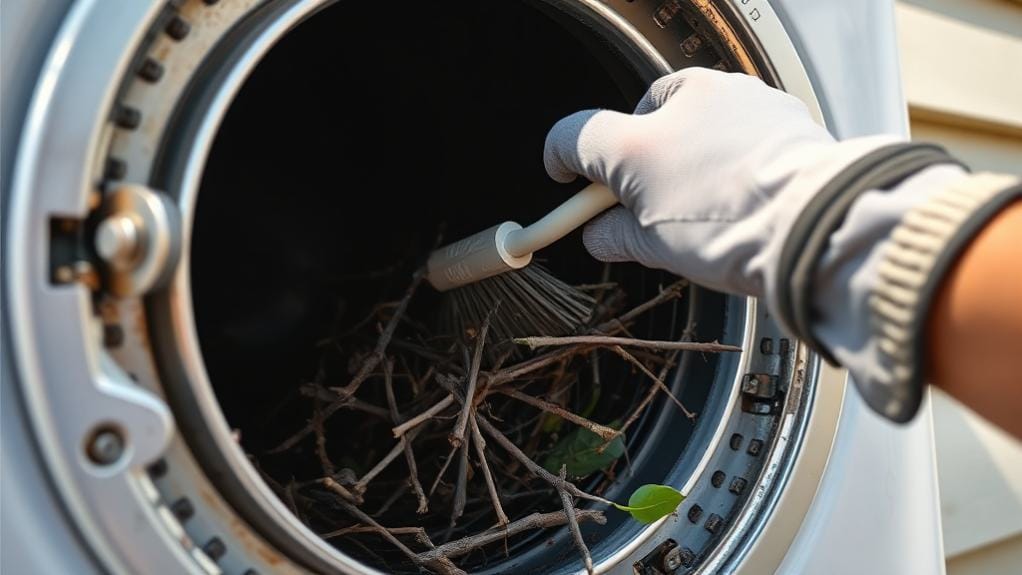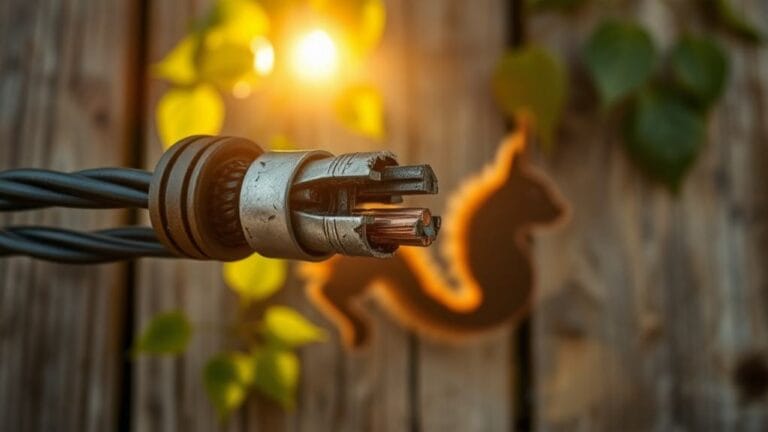Got an unwanted squirrel tenant in your dryer vent? Here's your game plan: First, confirm squirrel activity by listening for scratching and checking for nests. Time your removal when the critter's out doing squirrel stuff – usually early morning or late afternoon. Gear up with gloves, mask, and goggles (because who knows what's in there). Disconnect the vent, remove the nest with long tools, and vacuum thoroughly. Check for damage those little rascals caused, then install a heavy-duty vent cover to prevent Round 2. Still feeling unsure? There's more to this squirrel-evicting business than meets the eye.
Inspect and Confirm Squirrel Activity
Table of Contents
Several tell-tale signs can help you confirm whether squirrels have taken up residence in your dryer vent.
You'll want to inspect for these dead giveaways (because squirrels aren't exactly subtle house guests):
Just like increased squirrel sightings around your property can indicate an infestation, these pests leave clear evidence of their presence in vents.
- Listen for scratching sounds during daylight hours – yes, that's not your dryer having a nervous breakdown.
- Check those vent covers for chew marks and damage – squirrels love turning your plastic vents into their personal chew toys.
- Look for nesting materials like twigs and leaves around the opening – they're not trying to decorate, trust me.
- Scan for droppings near the vent area – nature's most unwanted calling card.
*Pro Tip: Grab a flashlight and carefully check the vent interior for nesting materials. But don't stick your hand in there – that's a rookie mistake you don't want to make.*
Wait for the Right Timing

Once you've confirmed squirrels have made your dryer vent their home, timing becomes your next key consideration.
You'll need to wait for the right timing to avoid turning this simple removal into a wildlife drama. Watch for gnawed insulation damage and unpleasant odors that could indicate a long-term infestation requiring more urgent attention.
Monitor the vent for several days and look for these vital signs of squirrel activity:
- Early morning movement
- Late afternoon quietness
- Nesting material going in or out
- Squeaking or scratching sounds
Pro Tip: Spring and fall are peak nesting seasons. Your timing needs extra attention during these months.
For humane treatment, never remove an active nest with babies.
Trust me – dealing with an angry squirrel mom isn't on anyone's bucket list. Wait until the babies have matured and moved out.
You'll thank yourself later for being patient and avoiding a furry confrontation.
Gather Essential Safety Equipment

Along with proper timing, having the right safety equipment is essential before tackling a squirrel nest removal.
Since natural deterrents like peppermint oil can help prevent future infestations, keep some on hand for after the removal.
Unless you enjoy catching diseases or getting your eyes full of debris, you'll want to gear up properly.
Here's what you absolutely need for safely removing squirrels and their nests:
- Heavy-duty gloves – because who knows what's lurking in that nest
- Face mask – trust me, you don't want to inhale whatever's in there
- Safety goggles – your eyes will thank you later
- Flashlight – because squirrels aren't known for their interior lighting skills
- Long-reach tool or tongs – keep those hands away from the mess
*Pro Tip: Double up on gloves if you're squeamish. Those nests can be pretty gross, and you'll want that extra layer of protection.*
Access the Vent System

With your safety gear ready, it's time to take on the actual vent system. First things first – unplug that dryer unless you enjoy unexpected electrical surprises. Safety first, folks!
While non-lethal traps are often effective, removing nests requires careful inspection of the entire system.
Head to the back of your dryer where that suspicious-looking duct disappears into the wall. That's your target. Grab your trusty screwdriver and disconnect the vent from your dryer. Don't worry if you find enough lint to stuff a mattress – that's normal.
Pro Tip: If you can't easily access or remove the nest, don't play hero. Call professional pest removal services.
Look for these telltale signs:
- Visible nesting materials
- Scratching sounds
- Debris around the exterior vent
- Strong musty odors
Check both the duct and exterior opening thoroughly before putting everything back together. Better safe than sorry when it comes to furry squatters!
Remove Nest and Clean Thoroughly

The actual nest removal requires methodical care and attention to safety.
You'll need to gear up with protective gloves and a mask – unless you fancy getting up close and personal with squirrel parasites (spoiler alert: you don't).
Watch for nesting materials like twigs, leaves, and moss that squirrels commonly use for insulation.
Grab those long-handled tools and remove nest materials carefully. No, your hands don't belong in there, no matter how tempting it might be to reach in and yank everything out.
Safety precautions aren't optional here:
- Vacuum thoroughly to prevent fire hazards
- Disinfect the vent area (because squirrel residue isn't exactly a fancy air freshener)
- Schedule professional duct cleaning
*Pro Tip: Don't skip the pro cleaning service – there's probably more debris hiding in there than you'd care to know about. Your dryer vents deserve better than being a squirrel's vacation home.*
Check for Structural Damage

Checking for structural damage after removing a squirrel's nest is essential to prevent future problems.
You'll need to inspect every inch of that vent system – and yes, that means getting up close and personal with your dryer's respiratory system.
Here's your damage control checklist:
- Look for teeth marks and chewed areas (squirrels aren't exactly gentle with your hardware)
- Check for loose or disconnected vent sections that these furry vandals may have knocked around
- Inspect for water damage or moisture – wet spots are a red flag
- Examine the exterior for entry points that could welcome future unwanted tenants
*Pro Tip: Don't skip checking the vent cover! It's your first line of defense against squirrels, birds, and other critters thinking your vent is their next vacation home.
Install Preventive Measures

Since squirrels are notorious repeat offenders, installing robust preventive measures becomes your next critical step.
Don't let those fuzzy troublemakers turn your dryer vent into their personal timeshare again! After completing the removal process, you'll need to fortify your vents against future invasions.
- Install a heavy-duty squirrel-proof vent cover that can withstand determined chewing – because trust me, they'll try their best to build another nest near your exhaust fan.
- Check the cover monthly for signs of damage or tampering (these critters are more persistent than your mother-in-law).
- Clear the surrounding area of anything that might attract wildlife – that means no bird feeders within 20 feet of your vents.
*Pro Tip: If you're not confident about animal removal techniques, hire a professional. It's cheaper than replacing your whole vent system after a DIY disaster.*
Frequently Asked Questions
What Do You Do if a Squirrel Is Stuck in Your Dryer Vent?
Don't try removing the squirrel yourself. Keep the area quiet and call a professional wildlife service immediately. You can gently tap the vent to encourage movement, but avoid traps or poisons while waiting.
How Do You Remove a Nest From a Dryer Vent?
While it's tempting to yank it out, you'll need to check for baby squirrels first. Use kitchen tongs to carefully remove the nest, then clean the vent thoroughly and install a protective cover.
How to Remove an Animal From a Dryer Vent?
Install a one-way door or humane trap near the vent's opening. Don't use your dryer until the animal exits. Once it's gone, clean the vent thoroughly and install a protective cover.
How to Get a Squirrel Out of Your Vent?
Listen for scratching, set humane traps near the vent, and install a one-way door. Once you've confirmed the squirrel's gone, clean the area thoroughly and seal entry points to prevent future visits.
Last Word
Don't let squirrels turn your dryer vent into their personal Airbnb. Just ask Bob from Cincinnati – he ignored chattering sounds for weeks until his dryer stopped working completely. A massive nest had transformed his vent into a cozy squirrel condo. You've now got the know-how to tackle this furry invasion safely and effectively. Remember: prevention beats eviction every time. Install that vent cover today, not after you've become an unwitting squirrel landlord.








